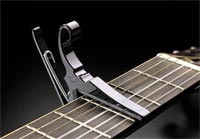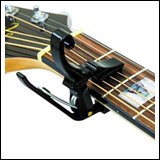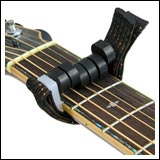Guitar Capo Buyer's Guide
If you've never used a guitar capo (pronounced Kay Poe), it's time you got one! They combine two of the best benefits of the world's great inventions: they do one thing very well, and they're inexpensive.
A guitar capo acts like an extra finger to press down one or more strings across your fretboard. This raises the pitch of each string. Changing the pitch of the strings means that you've changed the pitch of your guitar, and that means that you can simplify chord forms, or sing along to a song that is normally out of your vocal range.
Guitar capos come in many shapes, sizes, and finishes. Most work like a clamp. Some use a ratchet mechanism, and a few use cord to hold it in place. For the clamp type, you press down or squeeze on the clamp to open it (similar to a clothes pin), position it where you want it, then release it.
 |
All capos will have firm pliable material on the side that covers the fretboard, with additional padding on the side that presses on the guitar neck.
A good capo will have no protruding edges to scratch your guitar or to interfere with your fingers when you form chords next to it. It will go on, come off, and allow you to reposition it quickly. It will press the strings down to the fretboard and not slip.
A great capo will not push your strings sideways or create so much pressure on the strings that one or more strings are pressed out of tune. Several of the nicer capos have a mechnism to adjust the width of the capo. This allows you to customize the grip of the capo to minimize the pressure on the fretboard and neck.
What do you do with a capo when it's not in use? Some are easy to clip to your headstock, others may need to go in your pocket or on a music stand.
Capo manufacturers use a variety of methods to allow fast adjustments combined with firm attachments. The simplest designs use a spring... The capo opens and closes like a clothes pin. Some designs use an adjustable pin or screw... You adjust the pin/screw to a point that allows the capo to slip onto the neck of your guitar and stay there.
Typical colors are silver and black. Other colors may be available in some styles.
A Cut Capo
As your skills improve, you may find that you need, or want to experiment with, a cut capo. Cut guitar capos press down on some strings, and allow the rest to ring normally. Most are cut for two or more strings. Some are cut to allow the E string to ring normally. This means you can quickly create drop-D tuning. One, by Third Hand, lets you select which strings are capo'd and which are not.
| Popular Guitar Capos
Compare trigger type, adjustable, various finishes and more. |
 |
| Cut Capo
Clamp down some, but not all strings. Cut capos are easy to use, but only work on three adjacent strings. |
 |
| Third Hand Partial Capo
Third hand makes a capo that allows you to select any, or all strings. |
 |


